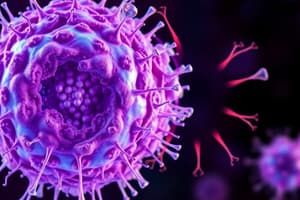Podcast
Questions and Answers
What are the 2 basic types of cells?
What are the 2 basic types of cells?
Prokaryotic cells and Eukaryotic cells
What is the main difference between prokaryotic and eukaryotic cells?
What is the main difference between prokaryotic and eukaryotic cells?
Prokaryotic cells lack a nucleus and membrane-bound organelles, whereas eukaryotic cells have a nucleus and complex organelles.
What is your favorite organelle and why?
What is your favorite organelle and why?
Answer may vary.
What molecules are present on/in the cell membrane?
What molecules are present on/in the cell membrane?
What are the two types of diffusion and their difference?
What are the two types of diffusion and their difference?
The outermost component of the cell that forms a selective barrier is called the ______.
The outermost component of the cell that forms a selective barrier is called the ______.
Which of the following is a function of the cell membrane? (Select all that apply)
Which of the following is a function of the cell membrane? (Select all that apply)
Flashcards are hidden until you start studying
Study Notes
Classroom Reminders
- Adhere to the dress code during laboratory sessions.
- Arrive on time to ensure full participation.
- Mute microphones to minimize distractions.
- Keep cameras on for better engagement.
- Come prepared with necessary materials.
- Sit still to maintain focus during class.
- Choose a quiet space to avoid interruptions.
- Show respect towards peers and instructors.
- Raise hand to speak, promoting orderly communication.
- Avoid eating during class to maintain professionalism.
Cell Types and Their Differences
- Two primary cell types: prokaryotic and eukaryotic.
- Prokaryotes are unicellular and include bacteria and archaea, lacking a defined nucleus.
- Eukaryotic cells are larger, more complex, and include organisms like fungi, plants, and animals.
Functions of Cells
- Cell metabolism and energy usage.
- Synthesis of molecules necessary for cellular functions.
- Communication between cells is vital for coordination.
- Reproduction and inheritance of genetic material.
Major Cell Parts
- Cells are the basic living units, highly organized to perform specific functions.
- Organelles are specialized structures within cells, each serving distinct roles.
Key Organelles and Their Functions
- Nucleus: Contains DNA and nucleoli, crucial for genetic information.
- Ribosomes: Sites for protein synthesis.
- Rough Endoplasmic Reticulum: Involved in protein synthesis, with ribosomes attached.
- Smooth Endoplasmic Reticulum: Synthesizes lipids and aids in detoxification.
- Golgi Apparatus: Modifies and packages proteins into secretory vesicles.
- Secretory Vesicle: Contains materials produced in the cell for exocytosis.
- Lysosome: Digests materials taken into the cell using enzymes.
- Peroxisome: Breaks down fatty acids, amino acids, and hydrogen peroxide.
- Mitochondria: Major site for ATP synthesis through aerobic respiration.
- Microtubules: Support cytoplasm and assist in cell division.
- Centrioles: Facilitate movement of chromosomes during cell division.
- Cilia and Flagella: Aid in movement, with flagella specifically important for sperm cells.
- Microvilli: Increase surface area for absorption in certain cells.
Cell Membrane Structure and Function
- Composed of a phospholipid bilayer with polar (hydrophilic) heads and nonpolar (hydrophobic) tails.
- Acts as a selective barrier regulating transport in and out of the cell.
- Facilitates cell recognition and provides anchoring sites for the cytoskeleton.
- Offers binding sites for enzymes and forms junctions to bind cells together.
Membrane Transport Mechanisms
- The cell membrane is critical in controlling the movement of molecules.
- Two types of diffusion: simple diffusion and facilitated diffusion, differing in requirement for transport proteins.
Studying That Suits You
Use AI to generate personalized quizzes and flashcards to suit your learning preferences.




